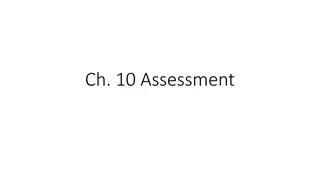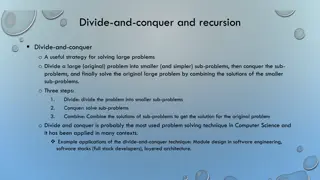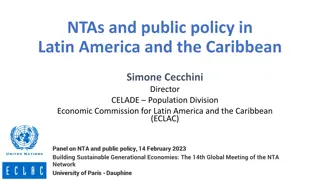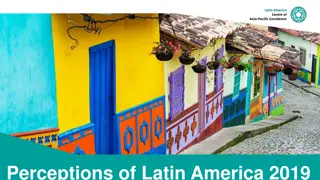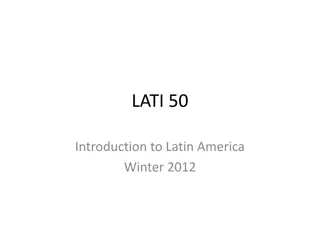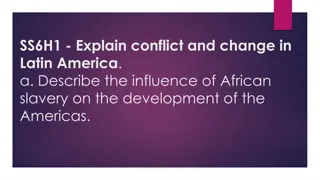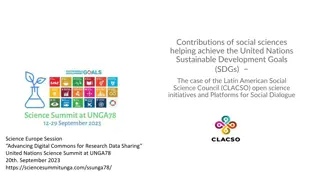Narrowing Latin America’s Digital Divide
Latin America and the Caribbean region face significant challenges due to COVID-19, including high infection rates, economic contraction, and social crises. Achieving positive outcomes in digital transformation is crucial, with a focus on pillars such as digital entrepreneurship, platforms, financial services, infrastructure, and skills. Disparities in the digital economy highlight the need for improved access and performance across various areas. Strategies to bridge these gaps can pave the way for a more resilient and inclusive recovery.
Download Presentation

Please find below an Image/Link to download the presentation.
The content on the website is provided AS IS for your information and personal use only. It may not be sold, licensed, or shared on other websites without obtaining consent from the author. Download presentation by click this link. If you encounter any issues during the download, it is possible that the publisher has removed the file from their server.
E N D
Presentation Transcript
May 10, 2021 Presentation to Woodrow Wilson Center Narrowing Latin America s Digital Divide
COVID has hit the Latin America and Caribbean Region harder than any other Region A Health Crisis o Over 20 million Covid cases in LCR since the start of the pandemic (about 1/5 of global cases (March 2021)); o Highest fatality rates among WBG client regions are in LCR; o Key drivers of the pandemic in LCR: o High levels of urbanization (80% vs. 55% globally); o High levels of informality; o Aging Population (LAC is aging faster than any other region (defined as highest change in the percentage of over 65 in total population). An Economic and Social Crisis o Expected contraction of 6.9% in 2020 (GEP January 2021) the worst performance in the developing world: two- fifths of LAC economies have experienced per capita GDP setbacks of 10 or more years. Small island economies hitparticularly hard o The debt-to-GDP ratio is expected to remain above other regions, at more than 80% o A decade lost in poverty gains o Sharp increase in inequality, food insecurity and learning poverty Increased Awareness of Role that Digital can play in Economies and Societies
Achieving good country-led outcomes in digital transformation requires an ecosystem approach 5 Foundational Pillars of the Digital Economy DIGITAL ENTREPRENEURSHIP Presence of an ecosystem that supports new and young firm growth to drive employment, innovation, and new technologies and business models DIGITAL PLATFORMS Presence and use of digital platforms that can support greater digital exchange, transactions and access to public and private services online DIGITAL FINANCIAL SERVICES Ability to pay, save, borrow, and invest through digital means, enabling access to and usage of digital services and increasing rate of online transactions DIGITAL INFRASTRUCTURE Availability of affordable, high speed internet, which is instrumental to bringing more people online DIGITAL SKILLS Development of a tech-savvy workforce, with basic and advanced digital skills to support increased technology adoption and innovation
LACs Digital Economy gaps are alarming Digital Infrastructure: 46% of fixed broadband access in the region, compared to 57% in Eastern Europe, 87% in Western Europe and 59% in the Asia Pacific region. Digital public platforms: Argentina, Brazil, Chile and Uruguay are among the top 50 performers in 2018, performing slightly below the OECD average. Belize, Cuba, Haiti and Nicaragua were among the worst LAC performers. Digital financial transactions: In 2019, the LAC region experienced the lowest growth rate (+2.5%, Western Africa 14.5%) in the number of registered mobile money accounts and the lowest growth rate in transactions value (+1.4, Western Africa +34.9%) Digital business: Venture capital investments present a positive trend. In 2019 Brazil and Mexico led the region in terms of number of deals and volume transacted (LACVA 2020). However, the region attracts less investment than Asia Pacific. (KPMG 2019) Digital skills: The levels of education and training in the region are low in relation to advanced countries. It is estimated that there are more than 450 thousand unfilled jobs in the technology area due to the lack of trained professionals. (IDC 2017).
Digital Infrastructure is the foundation of the Digital Economyyet LAC has significant gaps in terms of connectivity, usage and affordability Unequal and unachieved fixed-broadband agenda, especially in fiber On average less than half of the population (46.7%) in the Region have fixed broadband connectivity and even when they have it is of low quality (9.9% fiber to the home penetration) Advanced mobile broadband is lagging in LAC 4G covers 87% of the population with actual usage/penetration much lower (37%) 4G Market Penetration 100% 80% 120.00% 60% 100.00% 40% 80.00% 20% 60.00% 0% 40.00% 20.00% 0.00% Fixed broadband household penetration Fiber-to- the-premises broadband penetration Rural vs. urban digital divide varies significantly across LAC countries Rural areas are overrepresented in coverage and usage gaps Affordability remains a major barrier to Internet access and usage In developing countries, the cost of Internet access is often above 2% of GNI per capita for 1GB of mobile data. Device affordability is also major bottleneck. . 100 90 80 70 60 50 40 30 20 10 0 Urban Rural Sources: A4AI, 2019
MX and CA have not fully migrated to 4G; 5G remains a long shot - greatly limiting the ability for rich media content and applications (e.g. e-learning, e-health) 1.0 +Gbps 5G Commercial (GSMA 2021) 69% average smart phone ownership (GSMA 2020)
WB Advisory Services and Analytics (ASA) to close the Digital Divide ex. Colombia, Chile Chile Case Study: Proyecto de Fibra ptica Austral Objective: Provide fiber backbone and last mile local access service high-capacity telecommunications infrastructure for the south of Chile Budget: US $100 million Investment Model: PPP, subsidy award of Treasury Infra Fund (self funded) Policy Drivers: PPP framework Open Access and non-discriminatory, price capped tariff Award of spectrum (4G and 5G) / build out obligations ASA project assesses last mile rural community and peri- urban extension, additional policy and regulatory gaps (e.g. infrastructure sharing) and assess impact on buildout obligations and investment costs Colombia Case Study Part A: Program for Policy Reforms DPO Support: Objective: Increase competition and inclusion Key Measures: Subsidy and innovative award schemes Establish in-kind payments in exchange of spectrum use (up to 60% to total spectrum fee) Promotion of small operator subsidies as new entrants/competition Infrastructure sharing and interconnection regime Colombia Case Study Part B: Program to Increase Access Investment Support- Connect 1 million households (1 mill n de hogares) Objective: Increase the current fixed broadband penetration in households in Strata 1 and 2 in Colombia by 5 percentage points in order to reach the target of 50% by 2022 Budget: est. US $300-400 million (TBD) Investment Model: PPP, subsidy award of FONTIC (Universal Service fund)
Policy and Financial Support by the World Bank Leaping into the digital economy Bridging the digital divide DigitalInfrastructure (BroadbandandCloud) Strategic pillars Digital Skills Digital Platforms Digital Financial Services Sector diagnostics and policy based lending to increase competition in financial sector, ensure technology neutrality, and regulatory framework Foundational DI regulation Promoting infrastructure sharing Market liberalization, competition World Bank policy support (DPOs, ASA, RAS) Eliminate regulations that prevent development of private platforms Keep a level playing field Digital skills advisory work to fund deployment of digital skills programs by public and private sector World Bank investment (IPFs) Public investment in DI where private sector investment is not possible or economically feasible Investment in public sector platforms in social sectors including education and health, favoring a PPP model Public investment to crowd in private sector to support service deployment to rural areas or disadvantaged groups Fund government programs in education and vocations training Interventions build on each other as countries move towards more sophisticated solutions





